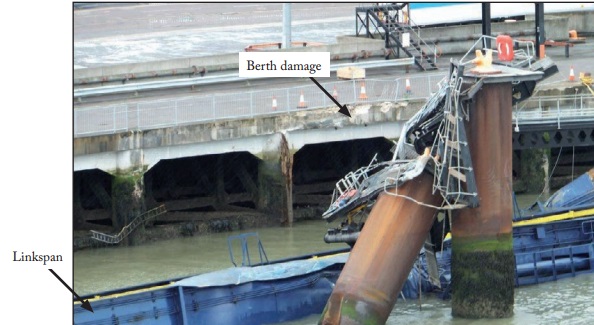A large roll-on roll-off passenger ferry, operating on its regular route between two European ports, suffered significant damage when it made heavy contact with a linkspan as it was being manoeuvred onto its berth. There were over 500 passengers and crew on board but no one was injured and there was no pollution.
 At about midday, the ferry’s master arrived on the bridge and took over command from the OOW in preparation for entering port. The OOW remained on the bridge to assist the master. The master was manoeuvring the vessel from the bridge’s centre console and was finding it difficult to identify which of its indicator lamps were illuminated. Realising the lamps had not been returned to full brightness after being dimmed overnight, the master attempted to adjust the brightness. Distracted by a conversation with the chief officer, he pressed the wrong button and inadvertently switched the vessel’s starboard controllable pitch propeller (CPP) from its normal control mode to its back-up mode.
At about midday, the ferry’s master arrived on the bridge and took over command from the OOW in preparation for entering port. The OOW remained on the bridge to assist the master. The master was manoeuvring the vessel from the bridge’s centre console and was finding it difficult to identify which of its indicator lamps were illuminated. Realising the lamps had not been returned to full brightness after being dimmed overnight, the master attempted to adjust the brightness. Distracted by a conversation with the chief officer, he pressed the wrong button and inadvertently switched the vessel’s starboard controllable pitch propeller (CPP) from its normal control mode to its back-up mode.
The error was not spotted by the master or his bridge team as they continued towards the port. However, a few minutes later the engineers in the engine control room noticed that the starboard CPP back-up control system indicator lamp was illuminated on their console. Having not seen this before, they discussed its significance before deciding to take no immediate action.
As the vessel entered the port the master reduced speed by decreasing the pitch settings on the port and starboard CPP control levers. When the vessel’s regular berth and vehicle linkspan came into view, the master went to the port bridge wing console and took control of the vessel’s propulsion, steering and bow thrusters. The OOW confirmed that the transfer of control had been successful and then joined the master on the bridge wing. However, neither of them noticed the faint glow from the CPP back-up indicator lamp on the bridge wing console.
With the vessel closing on the linkspan at about 7.5 knots the master continued to reduce the propeller pitch settings. The OOW assessed the speed of approach to be too great and advised the master. The master made further adjustments but quickly recognised that the vessel was not slowing sufficiently, and attempted to swing the bow away from the berth by setting one CPP to zero pitch and the other to full astern. However, the vessel’s bow swung rapidly the other way, towards the berth. In a final attempt to avoid heavy contact, the master set both control levers to full astern and the bow thrusters to full thrust away from the berth.
The master’s actions proved ineffective as the vessel tore through the linkspan at a speed of about 7 knots and made heavy contact with the concrete berth. Almost immediately, bilge alarms, indicating water ingress into the vessel’s forward spaces, began to sound. The pitch on both propellers was brought to zero but the main engines were kept running. The bridge team made safety announcements to the passengers, alerted the port authorities and requested tug assistance. The ship’s crew conducted an initial damage assessment and carried out emergency damage control measures. While these efforts were underway, one of the vessel’s CPPs was seen to be thrusting ahead, so its propulsion engine was stopped. The vessel suffered significant material damage and had to be removed from service and put into dry dock for repairs. No one was injured and there was no pollution.
Lessons Learned
- Ergonomically, the layout of the bridge console was not well designed. The close proximity of the safety-critical propulsion control buttons and the similar looking everyday use dimmer buttons, increased the likelihood of the type of human error seen in this case. There is always a risk that watchkeepers and equipment operators will inadvertently press the wrong buttons, particularly if they are tired or distracted. This type of risk is typically reduced on bridges and in engine control rooms by the fitting of protective covers over safetycritical buttons, switches and knobs.
- The master was confident that he had control of his CPPs and did not look at the pitch indicators located on the control consoles. Had he done so he would have realised the starboard CPP was not responding to his orders.
- The ship’s engineers recognised that something was untoward well before the master had committed to his approach, but chose not to alert the bridge team. Had they done so, it is likely that the bridge team would have diagnosed and rectified the problem. Engineers are put on standby in control rooms during manoeuvring operations for a reason; not least to keep the bridge team informed of the status of all safety-critical systems.
- The vessel’s crew were all experienced and many of them had spent most of their career operating similar types of vessels with the same company. However, the bridge and engineering teams did not fully understand the vessel’s propulsion control system and had not routinely tested their back-up and emergency controls. Regular testing of back-up and emergency control systems, and the conduct of machinery breakdown drills, provide the most effective method of ensuring the crew fully understand their ship’s systems and are best prepared to respond in an emergency.
Source & Image credits: UK MAIB






























































